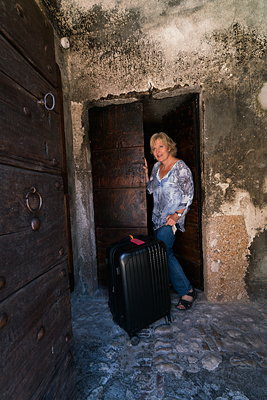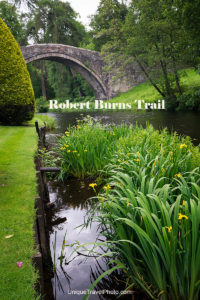Are you a literary fan? If so, take a fascinating diversion into southwestern Scotland and follow the Robert Burns trail. Spend a few days exploring the sites and scenery where Scotland’s favorite poet lived, farmed, wrote, walked and died. This circular route can depart from Glasgow or Edinburgh.
Itinerary planning tips are detailed below. Along with an alternate route that suggests additional side trips. But first, a little background...

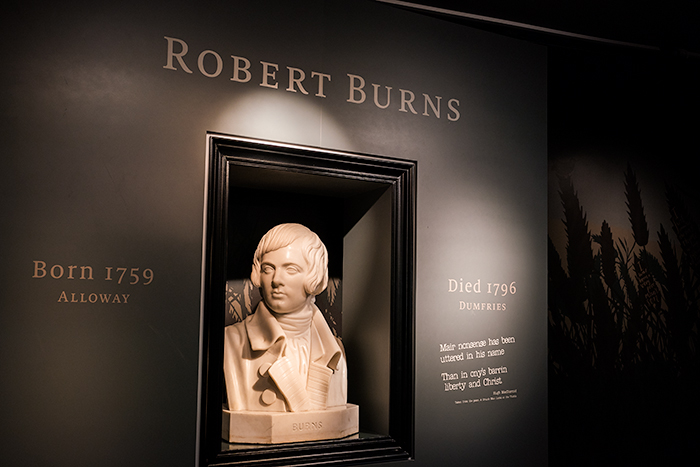
Who was Robert Burns?
If you’re Scottish, you know all about Rabbie Burns. If you’re not, you might not remember his name from high school English class. But if you’ve ever raised a glass to toast in the New Year and joined in the singing of Auld Lang Syne, well then, you are familiar with his work!
Robert Burns is Scotland’s beloved poet. England may have Shakespeare, but Scotland has Burns. Their National Bard.
In his short lifetime, Burns wrote 220 poems and 339 songs. Born to tenant farmers, the ‘Ploughman’s Poet’ created subtle satires written in Scottish dialect that evoked the spirit of a humble peasant with tender appreciation for the natural world, and celebrated the joy to think independently, to love, work, and show patriotic devotion to one’s country. He endeared himself to his fellow countrymen with his disdain for privileged classes in the 18th century, by elevating common honest men over dukes and lords in his poetry, rebelling against social classes that were determined at birth. His work appealed to peasants but also a broader audience, which includes a huge fan base in Russia and Canada yet today.
He is celebrated worldwide on his birthday, January 25th, with a Burns Supper where his poem ‘Address to Haggis’ is recited before the national dish is cut open with a flourish and served to waiting guests. His memory is also kept alive by devotees belonging to Burns Clubs scattered around Scotland and elsewhere in the world including Atlanta, Georgia.

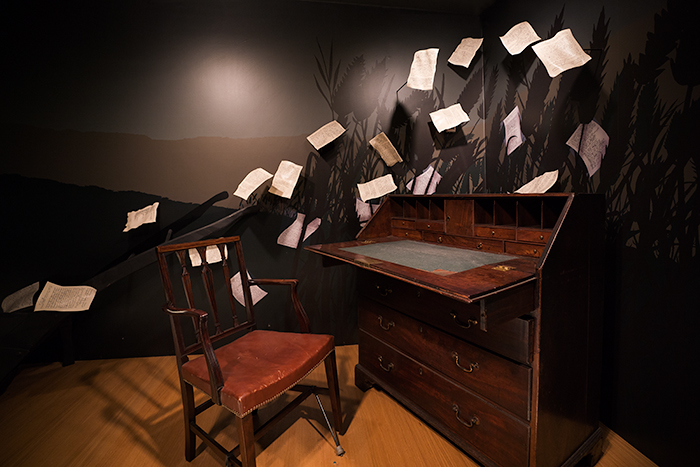
Exhibit of Manuscripts at Birthplace Museum
Burns POETRY
He often used small subjects to express bigger ideas in a humorous way.
His poem ‘To a Louse’ is perhaps my favorite. Burns speaks to a parasitic creature crawling on the fancy bonnet of a posh woman sitting in front of him in church. She begins primping thinking others are admiring her beauty, when in reality they’re staring at the bug. Two takeaways: 1) lice/insects/animals don’t care about social class and will seek out rich or poor humans equally as food; 2) too bad we don’t possess the ability to see ourselves as others see us! First and last 3 stanza’s of his poem:
Ha! whare ye gaun, ye crawlin ferlie!
Your impudence protects you sairlie
I canna say but ye strunt rarely
Owre gauze and lace
Tho’ faith, I fear, ye dine but sparely
On sic a place
——
I wad na been surpris’d to spy
You on an auld wife’s flainen toy;
Or aiblins some bit dubbie boy,
On’s wyliecoat;
But Miss’ fine Lunardi! fye!
How daur ye do’t?
O Jeany, dinna toss your head,
An’ set your beauties a’ abread!
Ye little ken what cursed speed
The blastie’s makin:
Thae winks an’ finger-ends, I dread,
Are notice takin.
O wad some Power the giftie gie us
To see oursels as ithers see us!
It wad frae mony a blunder free us,
An’ foolish notion:
What airs in dress an’ gait wad lea’e us,
An’ ev’n devotion!

.jpg)
‘To a Mouse’ (composed while still holding the plow in the field) was his apology for destroying the nest of the wee beastie and for man’s desire to dominate and control nature. It ends with the realization that no matter how we plan something in advance, it often goes awry. But that animals are blessed because they don’t dwell on mistakes, lament over what could’ve been or freeze with indecision about the future like humans do. Last 2 stanza’s of the poem:
But Mousie, thou art no thy lane,
In proving foresight may be vain:
The best-laid schemes o’ mice an’ men
Gang aft a-gley.
An’ lea’e us nought but grif an’ pain,
For promised joy.
Still thou art blest, compared wi’ me!
The present only toucheth thee:
But ouch! I backward cast my e’e
On prospects drear!
An’ forward though I canna see,
I guess an’ fear!
‘Red, Red Rose’ was a song that Bob Dylan claimed inspired him creatively more than any other.
Short and sweet and full of similes.
Which of his poems/songs is your favorite?

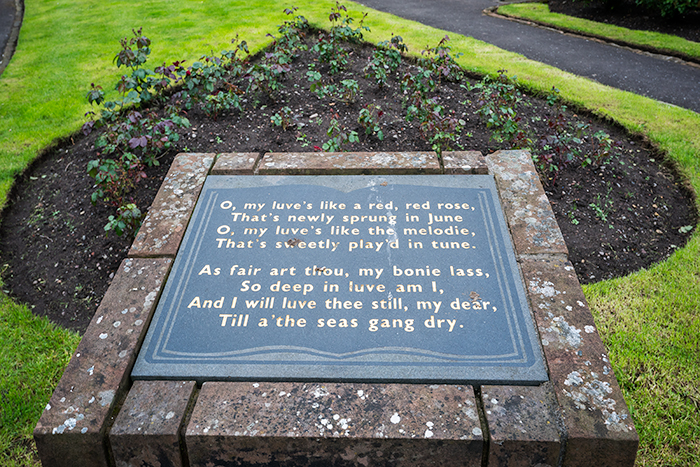
Poems and art are scattered around the garden across from his Dumfries home
His complete work of 559 poems and songs can be found on the website Robertburns.org, an excellent encyclopedic resource that includes a thorough biography of him and everyone he interacted with in his life. After poring over details found on the many (many!) pages there, excerpts from letters and biographies found online (by Cunningham & Crawford) plus visiting Burns sites in Scotland, I untangled the details and compiled the following chronology.
Why? Because context helps us understand what was happening in his life when he was living at the different destinations on this Robert Burns trail. And who inspired him. So let’s start in the beginning, his birthplace.
The LIFE of Robert Burns
ALLOWAY, Ayrshire, southwestern Scotland

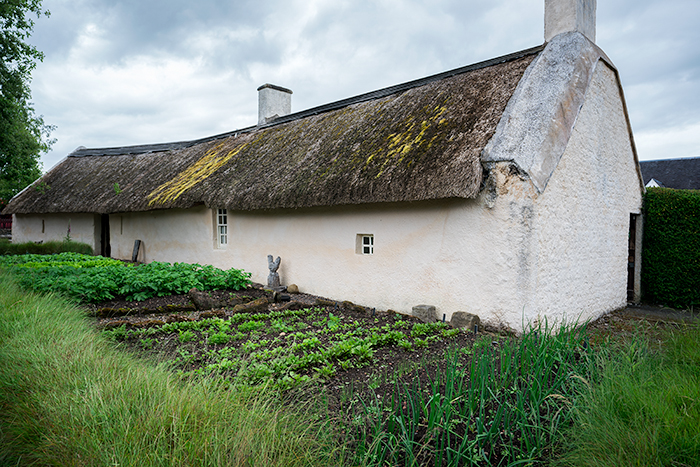
In the tiny village of Alloway, about a hour southwest of Glasgow, Robert Burness was born on January 25, 1759, the first child of William and Agnes Burness. His father built this rustic clay cottage where Robert lived for 7 years, and shared the box bed with 3 younger siblings. His mother sang ballads and folk songs to her son, instilling a love for lyrical stories and providing a solid foundation for shaping his ear and his career.

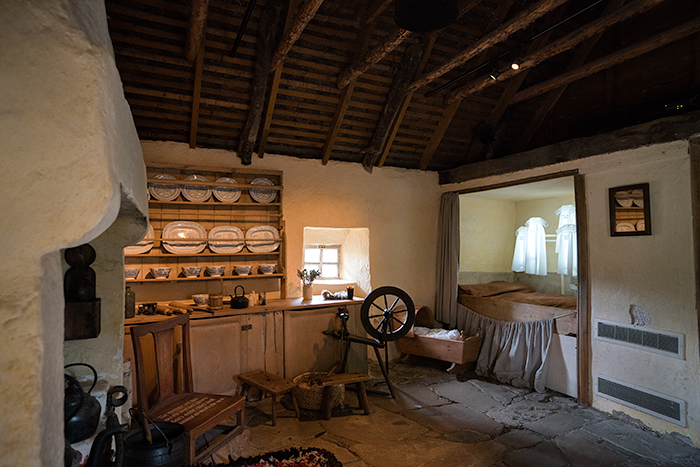 Oral traditions were our movies back then. As a young boy, Robert loved sitting by the fire listening to the spooky supernatural songs and stories that Betty Davidson told. The widowed woman who lived with them filled his imagination with tales of fairies, ghosts, giants, dragons, devils, warlocks and elfs which Burns later turned into poems.
Oral traditions were our movies back then. As a young boy, Robert loved sitting by the fire listening to the spooky supernatural songs and stories that Betty Davidson told. The widowed woman who lived with them filled his imagination with tales of fairies, ghosts, giants, dragons, devils, warlocks and elfs which Burns later turned into poems.
When 8, his family moved to Mt. Oliphant. Robert became the leading laborer on his father’s tenant farm, plowing difficult land which later contributed to his ailing health, a stooped back and weakened heart. He was schooled in the evenings by his father and by a tutor, Mr. Murdock. Burns wrote his first poem at age 15, the first of many about his love for a ‘bonnie lass.’

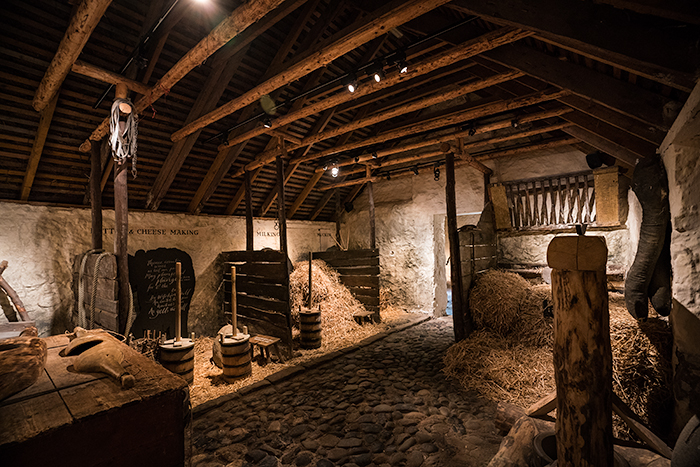
Their two room home attached to a barn where they kept their animals.
Adulthood
As an adult, he grew weary of the back-breaking farm work, and spent 6 months learning the trade of flax-dressing. But on New Years Eve, 1781, he accidentally burned the shop to ashes and was left without a dime. So back to farming he returned. When his father died a couple years later, he and his brother Gilbert decided to take on Mossgeil farm. They tried everything to improve methods for improved success, yet still lost half their crops. During this time he began to think of himself as an author, and his work delved darker into criticism of Calvinists. His ‘Holy Willie’s Prayer’ shocked the church clergy so much that he was forced to perform public penance, which further inspired him to write ‘The Lament’ and ‘The Ranting Dog the Daddie o’t.’
Burns was a social creature who loved to drink, laugh, banter and womanize.
His lovers
In 1785, at age 26, he welcomed his first child, born to Elizabeth Paton, a servant girl to his mother, with a poem entitled ‘Welcome to a Bastard Wean.’ (She was the first of 2 illegitimate daughters both named Elizabeth. He later had a 3rd daughter named Elizabeth with wife Jean.)
The next year he fell in love with Jean Armour and proposed to her. But his growing reputation as a dangerous rebel against orthodox religion prevented Jean’s father from giving his blessing, despite the fact that she was carrying Burn’s twins out of wedlock. In March of 1786, Jean’s father hired a local lawyer to void his daughter’s signed marriage contract and whisked Jean away to an uncle’s house in Paisley, near Glasgow. Then forced Burns to cough up money to raise his illegitimate children or face expatriation or jail time.
Frustrated, broke and feeling abandoned, Burns decided to emigrate to Jamaica to work as a bookkeeper on a plantation. His attention and affection quickly turned to another girl, Mary Campbell, who was working as a nursemaid in Ayrshire. Equally smitten, she agreed to join him in Jamaica. Burns shortened his name from Burness to Burns. On May 2nd, they secretly met at a stream and exchanged traditional Scottish marriage vows and Bibles at the River Ayr before she left for the Highlands to make necessary arrangements for their move overseas. He wrote several poems dedicated his warm-hearted Highland lassie, and a song, “Will ye go to the Indies, my Mary, And leave auld Scotia’s shore?”
To help raise money for his travels, he published Poems, Chiefly in the Scottish Dialect on July 31st, 1786 in nearby Kilmarnock. It was hailed an instant success by country folk and Edinburgh critics alike. “The Cotter’s Saturday Night” and odes “To a Mouse” and “to a Mountain Daisy” were considered the best poems in the collection, which sold out within a month of publication. At age 27, he had become an overnight sensation.
That October, Mary was on her way back to Burns. But before they were reunited, she suddenly died. Burns later wrote, At the close of Autumn following she crossed the sea to meet me at Greenock, where she had scarce landed when she was seized with a malignant fever, which hurried my dear girl to the grave in a few days, before I could even hear of her illness. The cause of her death is speculative. Some claim she contracted Typhus while nursing her brother, others believe she died during premature childbirth. (When her tomb in Greenock was opened during a cemetery expansion in 1920, part of an infant’s coffin was found inside her grave.)
EDINBURGH & Travels around Scotland
In November, instead of going to Jamaica, or sticking around Alloway for his twins (born September 3rd), he borrowed a pony and moved to Edinburgh. Here he had a second edition published, adding 22 new poems including his ‘Address to Haggis.’ Rubbing elbows with the elite, he reveled in the limelight as a guest at aristocratic gatherings where he was treated an an equal due to his international fame. Confident and poised, he exuded dignity and quick-witted intelligence and made a lasting impression on people in high society circles, including 16-year-old (Sir) Walter Scott. It was here that he met James Johnson, who commissioned Burns to edit a vast collection of Scottish folk songs, a project that would last 16 years.

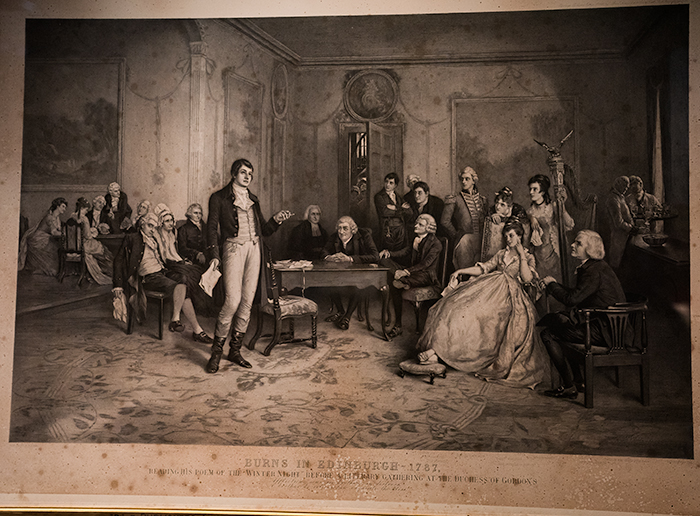
Painting by Steel, 1838, hanging in the Burns Birthplace Museum
Over the next year, 1787, he traveled around Scotland, visiting castles such as Stirling, Linlithgow (birthplace of Mary Queen of Scots), Crookston, and Scotland’s ancient capitol Dunfermline Abbey and Palace. At Clackmannan Tower, he was even ‘knighted’ with the sword of Robert the Bruce by his descendent, Catherine Bruce (who believed that she—being a staunch Jacobite—had a much greater right to bestow knighthood than English King George IV.) He toured the Highlands and also the Borders in southern Scotland, and was honored with receptions everywhere. Even by Mr. Armour(!) when Robert made a loop through Mossgiel enroute to Edinburgh.
High on fame, Burns had affairs some of which resulted in heirs. Jean Armour became pregnant with another set of his twins that summer. And Jenny Clow, the servant maid who delivered the letters between her boss Nancy ‘Clarinda’ and Robert in Edinburgh, produced a son, Robert Burns, in 1788. (This wasn’t his first namesake. Jean bore his illegitimate son, twin Robert Burns, in 1786.) But his most passionate affair was with Mrs. Nancy (Agnes) Maclehose, a 29 year old blond married to a lawyer, daughter of a prominent surgeon. After meeting him at a party, she invited him to tea. But his carriage overturned on the way leaving him injured and bedridden for weeks. And so their letter correspondence began. Nancy was the ‘Clarinda’ to Robert’s ‘Sylvander,’ pen names used to keep their romantic letters confidential during their long unconsummated affair. The famous letters were published by Nancy’s grandson in 1843 and became the basis for biographies, plays and musicals that continue to this day.

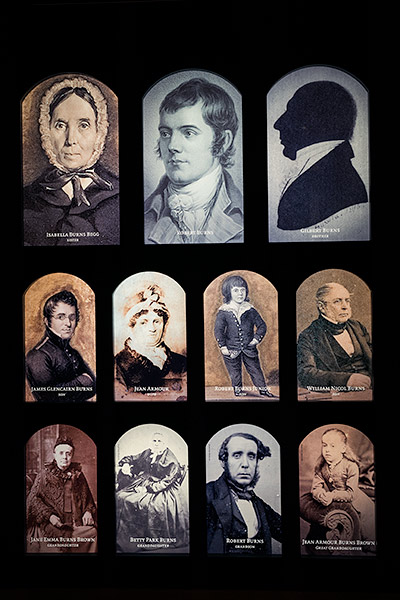
The people in his life, Birthplace Museum
DUMFRIES, southern Scotland
In February of 1788, Burns returned to Ayrshire when he learned that Jean Armour had been thrown out of her father’s house. (The details during this time period are sketchy. Perhaps Mr. Armour pushed her out due to her unwed pregnancy.) Burns immediately wrote Clarinda vowing his love to her instead of Jean ‘who disgusted him’ by comparison. But Clarinda urged him to marry Jean, which he did six weeks later in April. On March 3, Jean delivered twin girls, both of whom died within weeks.
Training and taking a position as an exciseman, Burns moved to Ellisland farm near Dumfries with Jean and their 2 year old toddler, Robert (his twin sister Jean died). They had an orchard, sheep, chickens, 4 horses and 9 cows on pretty pastoral property on the banks of the River Nith. But the soil was rocky and proved difficult for farming. Thankfully farming was not his only source of income.
Moving up the ranks, he took a position as Customs and Excise Officer for Dumfries in September. Jean was a forgiving wife who tolerated his melancholy moods and wandering behaviors. She bore him nine children, and graciously raised one of Robert’s illegitimate children, a daughter born to Ann Park, a barmaid at the Globe Inn tavern in Dumfries. Ann gave birth on March 31st 1791 to a daughter, Elizabeth “Betty” Burns, just a few days before his wife Jean gave birth to their son, William Nicol Burns.
Burns continued to write poetry while tending to the farm and collecting taxes on horseback. He often produced poems in a single sitting, preferring the solace of nature to the indoors. On October 20, 1789, overcome with sadness, he ignored his wife’s beckoning and stayed outside until he composed his moving ballad, ‘To Mary in Heaven’ on the 3rd anniversary of Highland Mary’s death. His longest, grandest poem ‘Tam O’Shanter’ was written while sitting on the riverbank at his farm. The poem was about a drunken Scot who stumbled across a creepy cemetery (based on recollections of the haunted Alloway kirk near his childhood home) where witches and warlocks were dancing, and how Tam races for his life and narrowly escapes the witches by crossing the Brig O’Doon.
Fun fact: Did you know that this poem inspired Michael Jackson to create his musical hit “Thriller?”

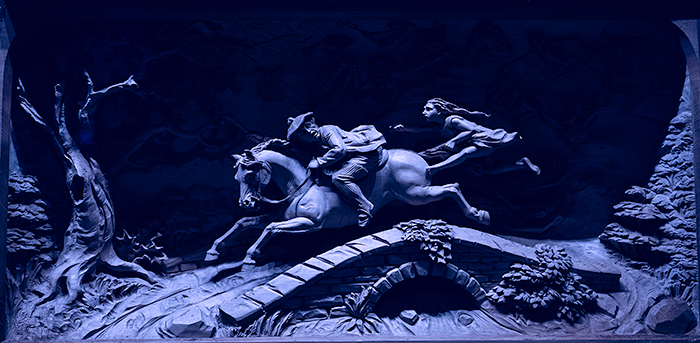
Tam O’Shanter sculpture by Thomas Tweedy, 1860, Birthplace Museum
Burns also continued collecting and adapting Scottish folk songs and creating original content. He contributed widely to both Johnson’s The Scots Musical Museum (1787–1803) and Thomson’s A Select Collection of Original Scotish Airs for the Voice (1793–1818) yet refused payment for either, believing it was his patriotic duty. Fourteen of the songs were dedicated to his faithful wife Jean. But his most famous song was ‘Auld Lang Syne.’
Leaving the Farm
After struggling to pay the £50 annual rent on his unproductive farm, he moved his family to Dumfries in November 1791. Soon after, he made a sudden trip to Edinburgh when Nancy (‘Clarinda’) informed him that her former servant Jenny Clow was dying from TB and had no one to else to turn to other than the father of her son for help. He went straightaway and spent 11 days at Jenny’s side. His final day in Edinburgh he reunited with Nancy, his Clarinda, and wrote a loving ballad ‘Ae Fond Kiss’ when he returned to Dumfries. Hailed as one of his best songs, it was one of nine songs written about her. (Wife Jean was fully aware of Burn’s affection and correspondence with Nancy. In 1821, when Jean was in Edinburgh, she had tea with Nancy ‘Clarinda’ Maclehose, who at age 64, still ached for her lost love.)
His steady income as a Customs and Excise Officer allowed him to move up from a cramped 2 bedroom flat to a much larger brick home with maid service in 1794, where he lived the last 3 years of his life. Honored for his bravery acting with 2 other Custom Officials to raid smugglers on the Solway shore, he made national news. Yet according to some biographies, he purchased 15 cannons and had them secretly shipped to France in support of their causes, expressing sympathy with the French Revolution. He wrote about his radical views, advocating for reform and democracy for all men. But when his political views became known, and questioned by his employers, he recanted and proved his loyalty to the Crown by joining the Royal Dumfries Volunteers in March 1795.
Deteriorating Health
That Autumn, his only legitimate daughter to survive past infancy, died at age 3. He was afflicted with such intense grief that he could no longer write anything but emotion fraught letters. By January, his health had deteriorated beyond his ability to work and he was writing letters asking for money.
Within six months, at age 37, Burns died from rheumatic fever with heart complications due to what we know now was bacteriological endocarditis. His doctor, William Maxwell, recommended a remedy which likely contributed to his demise. Following doctors orders, on July 4, 1796, Burns traveled 10 miles to Brow, waded up to his neck in the chilly waters of Solway Firth and drank iron-rich mineral water from Brow Well. He partook of this curative treatment for 14 days, but was keenly aware he was dying. Friends that stopped in to visit him were reportedly horrified at his frail condition.
From his ‘Brow-Sea-bathing quarters’ on July 7th 1796, Burns wrote his long-standing friend, Alexander Cunningham, who practiced law in Edinburgh:
‘Alas! My friend, I fear the voice of the Bard will soon be heard among you no more! For these eight or ten months I have been ailing, sometimes bed-fast & sometimes not; but these last three months I have been tortured with an excruciating rheumatism which has reduced me to nearly the last stage. You actually would not know me if you saw me. Pale, emaciated, & so feeble as occasionally to need help from my chair — my spirits fled! Fled! — but I can no more on the subject — only the medical folks tell me that my last & only chance is bathing & country quarters & riding. The deuce of the matter is this: when an Excise man is off duty, his salary is reduced to £35 instead of £50. What way, in the name of thrift, shall I maintain myself & keep a horse in Country quarters with a wife & five children at home on £35? I mention this, because I had intended to beg your utmost interest & all friends you can muster to move our Commiss of Excise to grant me the full salary. I dare say you know them all personally. If they do not grant it me, I must lay my account with an exit truly en poete, if I die not of disease I must perish with hunger…’
(Alexander came through for his friend in the end, raising funds for Jean Armour and her children.)
In a gravely weakened state, Burns returned home in a carriage, struggled to walk through the door, and collapsed in bed. His wife was also bed bound. But for the opposite reason. At nine months pregnant. she was ready to give birth.
Burns died 3 days later. He was buried with full military honors with thousands in attendance. Except his wife. During his funeral, Jean was delivering their last child. She named him Maxwell.
Robert was buried in St. Michael’s churchyard with a simple slab. Seven years later, when English poet William Wordsworth came to pay his respects and had a hard time finding the grassy grave, he was so outraged at the simplicity that he wrote a poem ‘July 21 at the Grave of Burns’ which instigated a monument more fitting for Scotland’s national bard. Burns’ friend John Syme formed a committee that built the mausoleum in 1813 that we see today.

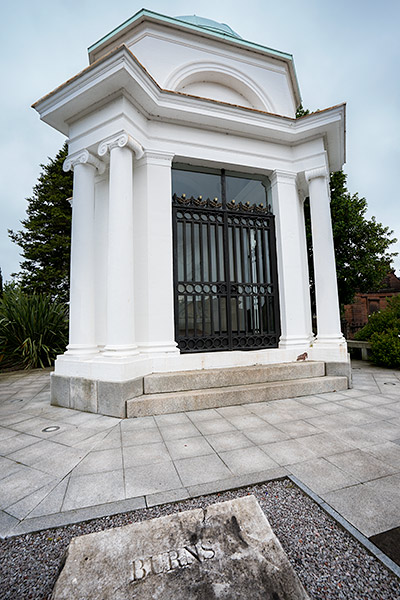
Hungry for more? There’s so many more fascinating stories, details, relationships and political viewpoints…
Check out these books:
The Bard: Robert Burns biography by Robert Crawford (2009) relies on the author’s own letters, poems, notes and documented facts to produce the most comprehensive biography ever written. A hefty read for serious fans.
The Complete Poems & Songs of Robert Burns (2012) presents his work in chronological order along with helpful notes to clarify the meaning of the verses (better than a teacher’s edition) and a glossary to translate Scottish words. (Would’ve been nice to have when I was teaching high school English!)
ITINERARY TIPS for visiting sites along the Robert Burns trail

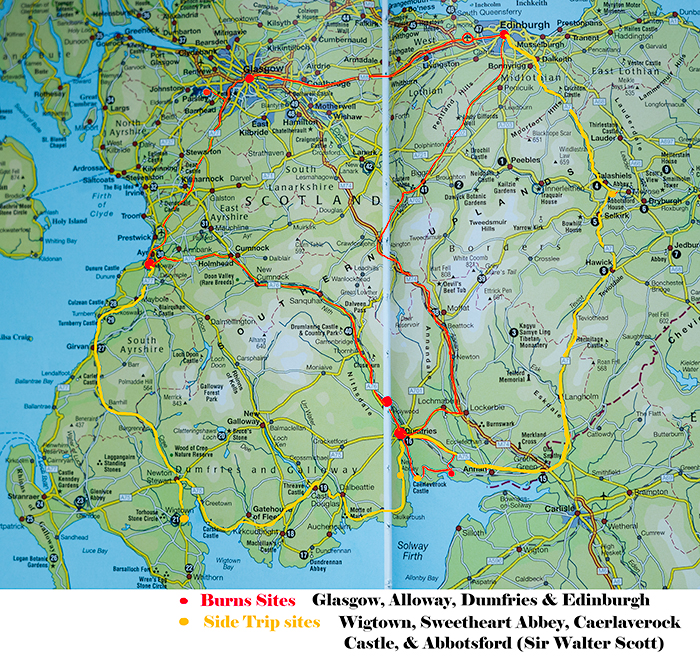
The route can spread from 1-3 nights, or longer, depending on your interest. Ideally, begin in Glasgow and end in Edinburgh (a one hour train travels between the cities). A car rental is your best bet if you want to take side trips. Trains are an option between the cities of Glasgow, Ayr, Dumfries and Edinburgh. Buses are less frequent in the southwest, resulting in too many transfers and a very long trip.
* If extremely limited on time and money, here’s an idea! Fly to Scotland on discount air carrier RyanAir to Prestwick Airport (30 miles SW of Glasgow) and travel ten minutes to Burns’ birthplace using Uber or taxi ($30-$46 RT). Visit sites in Alloway on a day trip before catching the 1 hour train from Ayr to Glasgow city center to continue your journey in Scotland.
Glasgow
TRAVEL Glasgow airport to Alloway: Allow 1 hour by car.
Car rental: Travel between Glasgow airport and Alloway is 40 miles & takes 55 minutes depending on traffic at the roundabouts. Travel south on A77 to Ayr, and drive 2.5 miles south on B7024.
Public transportation: Travel time by bus takes 3.5 hours. A better option is the train.
Train: Glasgow airport to Prestwick airport (1 hour, 1 transfer, $15) then hire an Uber ($15) for the 10 min drive to Alloway. Or if already in town take the train from Glasgow city center to Ayr (1 hr, $15) then 10 min Uber ride to Alloway.
Sites in Alloway:
Birthplace Museum Run by the National Trust for Scotland, the Robert Burns Birthplace Museum has 5,500 artifacts including original manuscripts, photographs, paintings and sculptures depicting his poems, letters, musical instruments and personal objects like his writing utensils and the pistols he handed Dr. Maxwell on his deathbed. There’s a short film, games, quizzes and even a Burns jukebox. Excellent museum even if you’re not familiar with his poetry. Admission: Adult £10.50 Family £24.50. Open 10-5pm. Plenty of parking. Other landmarks and sites are within walking distance along the Poet’s Path through landscaped gardens.


Don’t skip the cafe at the museum. Offers yummy and healthy fare also bacon rolls, homemade pastries, scones and desserts. Separate line for hot items (12-3pm) includes daily specials, soups, sandwiches, haggis and a Ploughman’s platter with a selection of cheeses, rustic bread, fig chutney and ham.

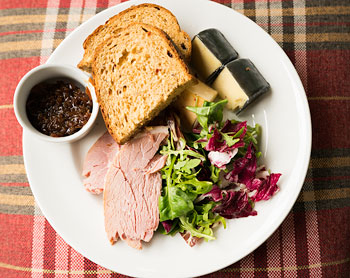
Ploughman’s lunch at the Cafe
Brig O’Doon A short walk away from the museum is this 15th c cobblestone bridge featured in Burn’s ‘Tam O’Shanter’ poem where his mare lost his tail to witches as Tam crossed in haste.

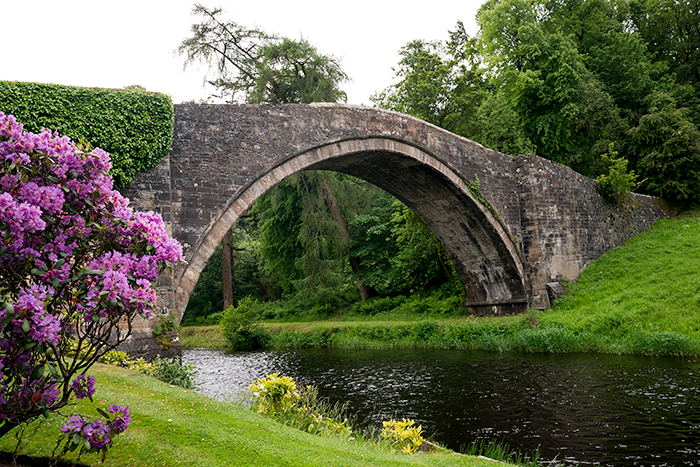
Alloway Auld Kirk This cemetery is where Robert’s younger sister and father William are buried. The epitaph that Robert wrote is engraved on the backside of the William’s tombstone.

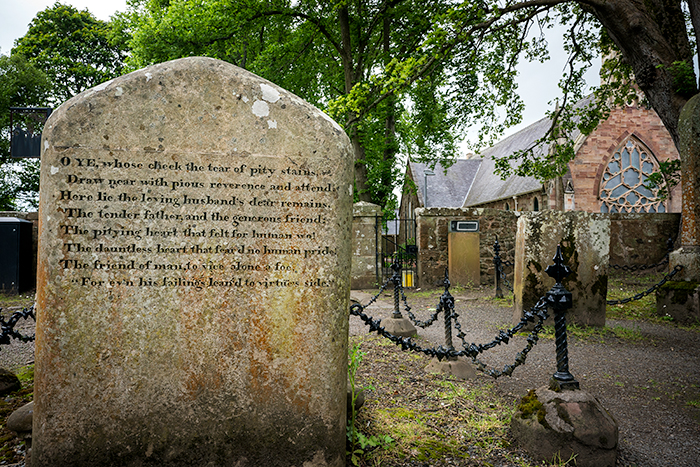
The 16th c church in the background was already in ruins when Burns was alive. This eerie place was surely etched in his mind as an impressionable child as he later chose it as the setting for the witches dancing in the dark in his supernatural poem ‘Tam O’Shanter.’

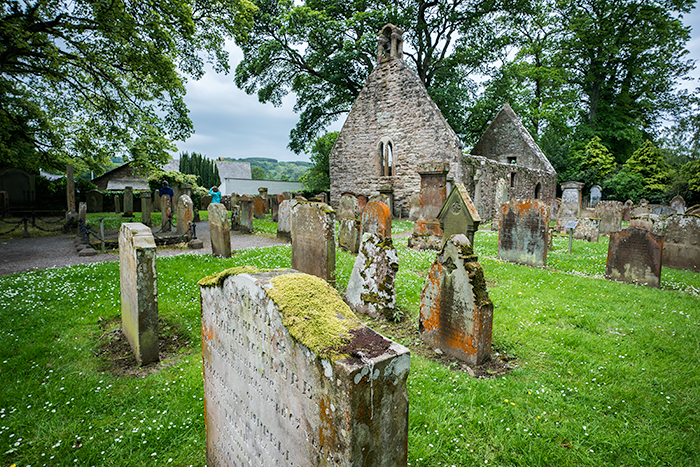
Birthplace Cottage and garden is a short walk away from the museum. Walk through the 2 room cottage and barn where Burns spent his first seven years.

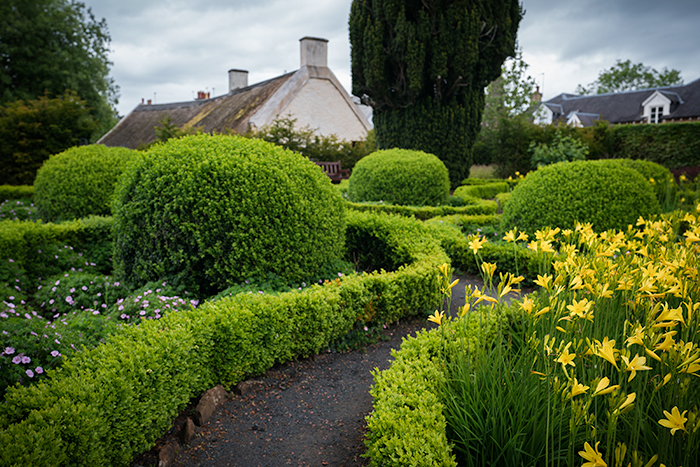
Allow around 3 hours for your visit. Depending on when you arrived in Alloway, you may want to spend the night. Or carry on to Dumfries.
HEADING SOUTH
Or take a side trip to Wigtown, Scotland’s National Book town! Book lovers will adore this quaint seaside town where you can browse through the dozen independently owned second-hand book stores. Best places to find Burns books? I can vouch for great selections at The Book Shop and The Old Bank, both on Wigtown’s main street. Just don’t plan your visit for Sunday when most of the bookstores are closed. Very affordable lodging. (Post about my Wigtown visit here.)
Travel: Alloway to Wigtown: 1 hour 20 minutes, south on A714. Visit for an afternoon or stay the night. Then travel from Wigtown to Dumfries: 1 hour 15 minutes heading northeast on A75.

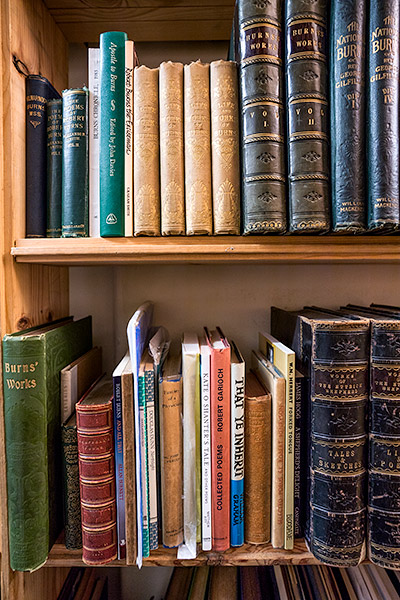
Burns books in Wigtown, Scotland’s Book Town
TRAVEL Alloway to Dumfries: Allow 1.5 hours by car.
Car rental: Distance is 57 miles, and takes around 1.5 hours. Stop at Ellisland Farm along the way (5 miles before reaching Dumfries off of A76).
Train: There are 11 trains between Ayr and Dumfries ranging from 1 hr 40 min to 3 hours beginning at £13.10.
Sites around Dumfries:
Ellisland Farm See the farmhouse that Burns built for his bride Jean and their 2 year-old Robert on the 170 acre farm that he leased. Watch a film about their life here, learn about the dairy farming they attempted, their growing family (2 more sons were born here), their daily routines in the 18th century, and the belongings that once belonged to the poet and his wife. Wander down to the riverbank to visit the spot where he wrote his masterpiece ‘Tam O’Shanter‘ in a single sitting. Burns was inspired to write many songs here including the reworked current adaption of Auld Lang Syne.
His creative efforts were more productive than the stony barren soil, and within three years he gave up farming. He prospered however as a tax collector, or Excise Officer. Burns got out of his lease when a neighbor showed interest in purchasing it, and moved to town. Ellisland was farmed until 1921, when a wealthy Burns admirer purchased the farm and generously donated it to the nation as a Burns museum.
Just north of the property is the Robert Burns Hermitage, an adorable stone hut where he liked to write. Monks from the Melrose Abbey used to live on this wooded land. It was here that Burns met a man who requested a witch story, and of course we all know what poem that turned out to be!
Check Ellisland Farm website for special events, such as the Farm Dinners with music and storytelling (next one Sept 14, 2019) or Kitchen Ceilidh storytelling and songs (October 9, 2019) that mimic a typical social evening of that time period. (I wanna go!)
Allow 1-3 hours to visit. Open Mon-Sat 10-5pm (closed 1-2pm), Sun 2-5pm. Admission: adults £5.00
Directions from Alloway: take A770 east to A76 and follow southeast toward Dumfries.

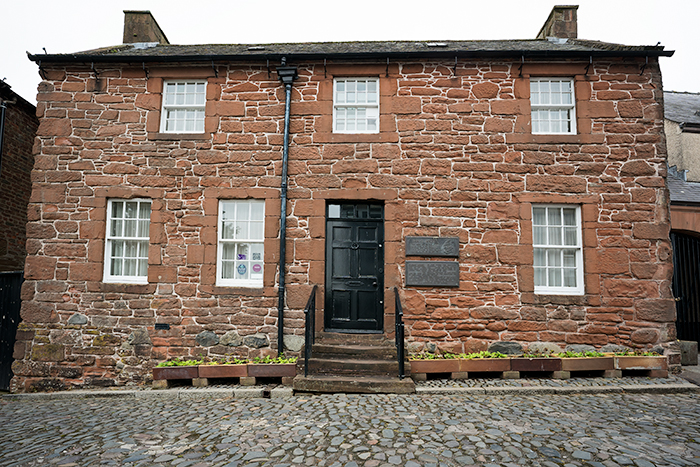
Burns House
Burns lived here the last 3 years of his life with his wife, children and maid. Located on Burns Street a block’s walk from St. Michael’s church. Tourist signs will point the way once in town. His former home is a museum where tourists can see typical furnishings from the 18th century. Look for his name etched in the window glass near his writing desk.
His wife refused to move from here when he died and kept all the children together instead of handing them out to assorted relatives as she was being encouraged to do. Dr. Maxwell was one of the three Trustees (with Cunningham & Syme) who helped collect money to financially support Burns’s widow and children. Young son Maxwell died 3 years later. Another son, Francis, died 7 years after his father, in the same bedroom. Only 3 of her 9 children lived to be adults. Jean lived another 38 years, but needed assistance from her granddaughter Sara when she suffered partial paralysis from a series of strokes, but lived here until her death. Free admission. Open 10-5pm.

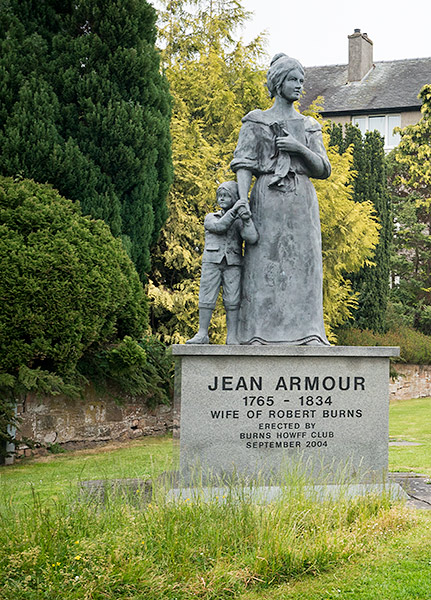
Jean Armour and son statue near their home
Mausoleum
Final stop on the Robert Burns trail is where Robert is buried along with his wife, 3 year old son Maxwell, 14 year old Frances, and 70 year old eldest son Robert. Look for the white domed structure to the right behind St. Michael’s church. As you wander around the St. Michael’s cemetery, note the strange table top graves and the tombs of Burn’s contemporaries marked with a blue plaque.

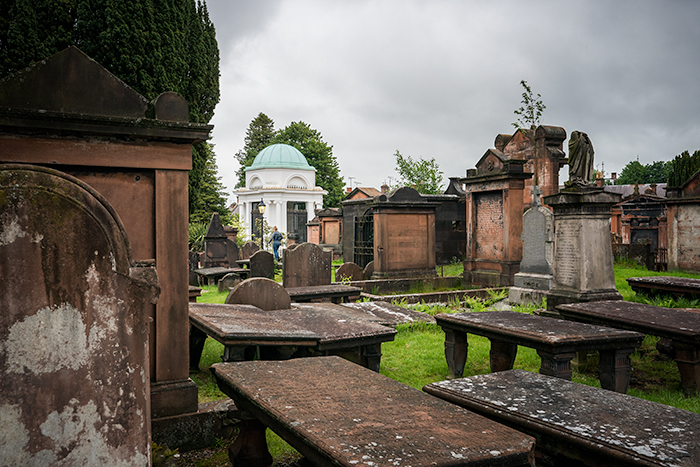
Peek inside the mausoleum to see the elaborate marble carving of ‘Coila’ a goddess-like figure throwing inspiration over Burns as he plows the land.

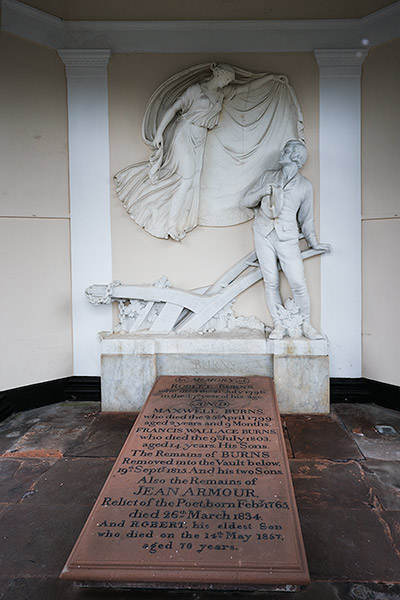
Robert Burns Centre located in a 18th c stone mill on the River Nith has exhibits and books about his life and a audio-visual film. It shows contemporary cinema shows in the evening. On Mill Road.
Globe Inn established in 1610 was Burns’ favorite pub. He stayed upstairs during busy tax season, and left his mark (literally) on the window pane by etching 6 verses. Evening were spent drinking and discussing poetry or politics. The chair where he liked to sit by the fireplace is still there. But beware. If you sit in it and can’t recite one of Burns’ poems your penalty is buying a round of drinks. 56 High Street.
Burns Festival Dumfries throws an annual festival called the Big Burns Supper for 10 days beginning in late January. Events for adults include a Burlesque show. Check the website to see the line up for performing arts, music, poetry, and the procession on Carnival Night. Get your tickets in advance, as events sell out quickly.
Brow Well is ocated near Ruthwell, a tiny spot off of B725, 10 miles southeast of Dumfries. This is where Burns drank iron-rich mineral water from the sandstone tank and walked down the lane to bathe in the cold waters of Soloway Firth in a last ditch effort to cure his diseased body during the last two weeks of his life. The rustic inn where he stayed is no longer there.
Worthwhile diversion
On the way to Brow Well: Caerlaverock Castle. This formidable triangular-shaped medieval castle sits in a moat. Located 9 miles down the road, directly south of Dumfries on the single track road B725 it veers west instead of east to Brow Well. Beyond the unassuming turn off to the castle is Caerlaverock Nature Reserve with animal hides for watching birds, namely ospreys. Surely Burns would’ve visited this castle on his travels around Dumfries as Excise Officer, but I cannot find any reference to it in his work. (Read my post about visiting Caerlaverock Castle here.)

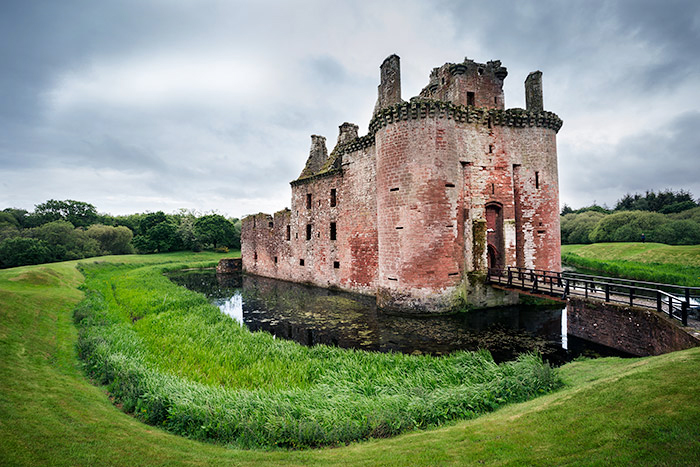
Dumfries, a small town of 30,000 people, has affordable lodging and makes a good base for exploring Burns sites and taking side trips to Caerlaverock Castle ruins or Sweetheart Abbey, both within ten miles of the city.
The Sweetheart Abbey ruins date from 13th c and come with a romantic story that Burns surely would’ve heard. In 1268, Lady Dervorgilla put her deceased husband’s heart in an ivory box and carried it everywhere, even in death. She established the abbey as a loving tribute to her husband, John Balliol. Many years later, during the Reformation, the last Abbot to live and worship here was imprisoned in the Blackness Castle for his defiance of not reforming to the new order, and five years later exiled to France. Wander through grand sandstone arches and cloister. Located 5 miles from Dumfries, open daily 9:30-5:30pm (closed Thursday & Friday during Oct 1-Mar 31) Admission £6.
HEADING NORTH
Alternate route heading north through the BORDERS to visit Abbotsford, Sir Walter Scott’s mansion. This side trip adds an hour travel time from Dumfries to Edinburgh.
Dunfries to Melrose is 78 miles, and takes 1 hr 45 min. Drive east on A75, north on A7. Or shave off 30 minutes and travel on A701/708 through Moffat.
Melrose to Edinburgh is 36 miles, and takes an hour on A7 heading directly north.
Abbotsford House is the turreted fairy-tale mansion where Ivanhoe author Sir Walter Scott lived from 1812. Armory, chandeliers, paintings and carvings, the interior is on par with that of castles. Opulent. Elegant. A place where you can almost hear his daughter Sophia playing the harp. But the highlight for any literary fan is surely his magnificent leather-bound library with over 9,000 rare books and manuscripts, on every subject imaginable! On site restaurant, high-end lodging and formal gardens too. What a contrast to the plain humble abode of Burns! Open daily April-Oct 10-5pm. Check website for winter hours. Admission £11.20.
Melrose Abbey is one the Border’s most impressive ruins. Built in 1136, this monastery with red sandstone arches is a great place to stop if you didn’t make it to Sweetheart Abbey. This too is the burial space of an isolated heart. One that belonged to Robert the Bruce. Open daily 9:30-5:30pm (10-4 winter). Admission £6.
TRAVEL Dumfries to Edinburgh: Allow 2 hours by car.
Car rental: Distance is 78 miles, and takes around 2 hours. Drive north on A702.
Train: There are 20 trains between Dumfries and Edinburgh ranging from 2 hr 24 min to 3 hours 41 min, beginning at £9.10.
In Edinburgh:
All of the sites are located near the Royal Mile in Old Town. This is perhaps Scotland’s most expensive city. Consider an apartment over a hotel even if staying overnight.
St. Giles Cathedral has a Robert Burns stained glass window that was created in 1985 by an Icelandic artist. Look for it by the entrance. The window shows Burns connection to the land with green glass at the bottom, his connection to fellow brethren with a circle in the middle, and his creativity with a red sunburst representing his popular song about the red, red rose at the top of the window. (I sadly forgot to look for it in my rushed visit.)

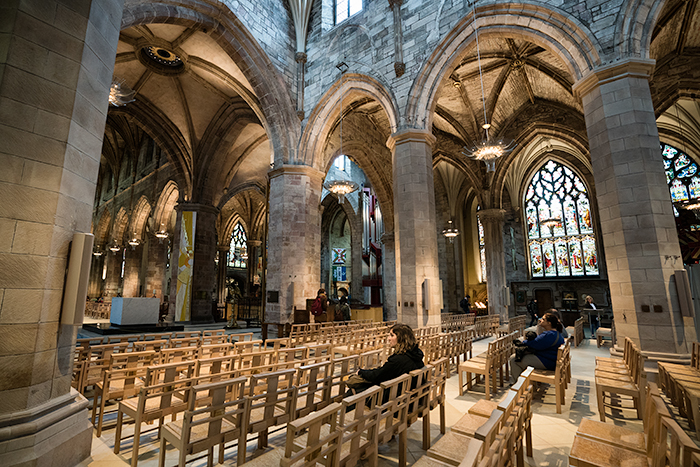
St. Giles Cathedral
The Writers’ Museum celebrates the lives of three great Scottish writers – Robert Burns, Sir Walter Scott and Robert Louis Stevenson. Manuscripts and personal effects of these literary greats, including Burns’ writing desk, are exhibited in the top floor of Lady Stair’s House built in 1622. This is exactly the type of aristocratic home where high society gathered during Burns time and listened to him recite his poetry. Don’t miss the room that has audio recordings of his poetry! Tuck into the narrow Lady Stair’s Close on Grassmarket. Free. Open Mon to Sa: 10-5, Sun 12-5.
Deacon Brodies Tavern is the spot where Burns lived in a house that’s no longer there. Located one block north of St. Gile’s Cathedral, 435 Lawnmarket. Across the street, pop into Deacon’s House Cafe for tea, soup and excellent homemade scones!
Beehive Pub on Grassmarket is the meeting place for a Literary Pub Tour where 2 professional actors debate the literary greats. Their website describes the night as “a lively duel of wits, they question the importance which the unique pub atmosphere offered creative and intellectual thought, while battling between perspectives and stories from “Auld Reekie.” (I didn’t have the chance to take their tour on my disastrously shortened one night visit, but will next time. What a fun idea!)

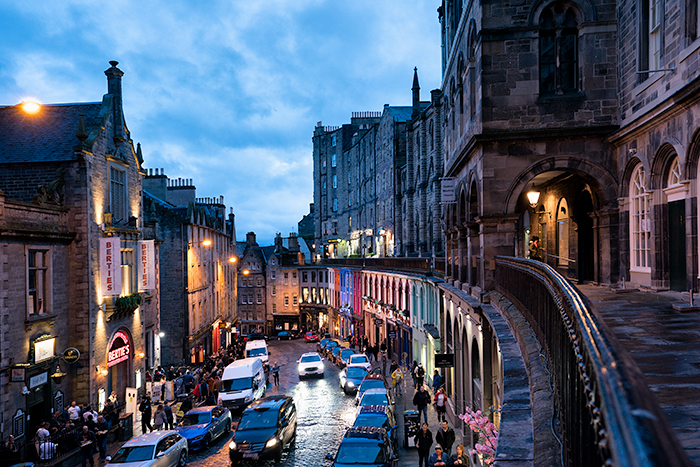 To help plan your getaway on the Robert Burns trail check out lodging options for your dates on the Booking.com map below. Scroll to find destinations where you want to stay–Wigtown? Dumfries? Alloway? Edinburgh? Glancing at the choices helps visualize the affordable options.
To help plan your getaway on the Robert Burns trail check out lodging options for your dates on the Booking.com map below. Scroll to find destinations where you want to stay–Wigtown? Dumfries? Alloway? Edinburgh? Glancing at the choices helps visualize the affordable options.
[booking_product_helper shortname=”royal mile”]
There’s just something tangible about visiting places where books, songs or poems were written.
And wandering around Burns sites in southern Scotland was no exception. Having never delved into his life or taking the time to understand the context behind his poetry until this visit, I can attest that it brought greater depth to his work. And what a pretty place to explore…
So to you Burns fans out there, grab the chance and GO! What are you waiting for?
Pick a pic and Pin to your Pinterest board for later!



